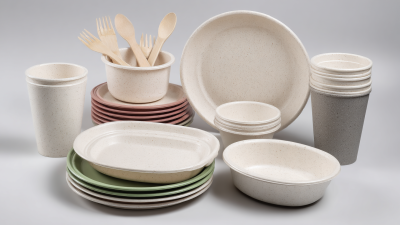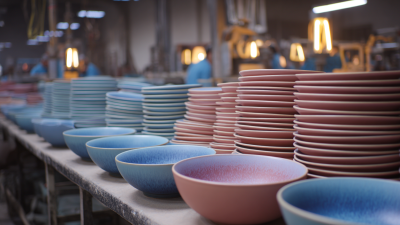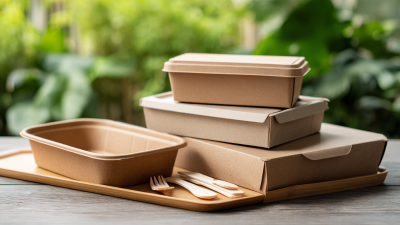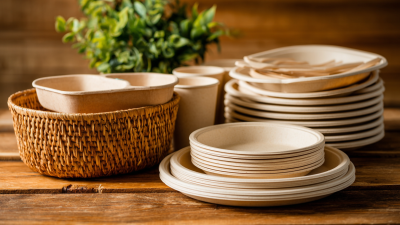In recent years, the conversation around sustainability has gained tremendous momentum, prompting individuals and businesses alike to seek eco-friendly alternatives to traditional dining options. One of the most promising innovations in this space is compostable tableware, which offers a viable solution to the growing problem of plastic waste. As consumers become more environmentally conscious, the demand for products that align with their values is rising, leading to a shift towards compostable materials that decompose naturally and enrich the soil. This blog will explore five compelling reasons why compostable tableware is not just a trend but the future of sustainable dining. From its minimal environmental footprint to its ability to enhance the dining experience, compostable tableware stands at the forefront of a responsible revolution in how we approach food service. Join us as we delve into the top strategies for embracing this essential movement toward a greener planet.

As the world becomes more environmentally conscious, compostable tableware is emerging as a viable alternative to traditional plastics. One of the key benefits of compostable tableware is its biodegradability. Unlike conventional plastic, which can take hundreds of years to break down, compostable materials are designed to decompose within a few months when exposed to the right conditions. This rapid breakdown not only reduces landfill waste but also enriches the soil, promoting healthier ecosystems.
Another significant advantage is the reduction of chemical pollutants associated with plastic production and disposal. Traditional plastics often contain harmful additives that can leach into the environment, posing risks to wildlife and human health. In contrast, compostable tableware is typically made from natural materials that do not release toxic substances. This makes it a safer option for both consumers and the planet, helping to create a cleaner and more sustainable dining experience.
By choosing compostable over traditional plastics, restaurants and individuals alike contribute to a greener future while enjoying the convenience of disposable dining solutions.
The rising concern for environmental sustainability has placed compostable tableware at the forefront of eco-friendly dining options. Traditional single-use plastics contribute significantly to landfill waste, with the Environmental Protection Agency (EPA) estimating that plastics accounted for around 27 million tons of municipal solid waste in 2018. Each year, millions of these items can take hundreds of years to decompose, leaching harmful chemicals into the soil and waterways. Compostable tableware, made from renewable resources like corn starch and sugarcane, offers a viable solution by breaking down within months under the right composting conditions, thus reducing the burden on our landfills.
Research conducted by the Biodegradable Products Institute indicates that compostable products, when properly disposed of, can reduce greenhouse gas emissions by 50% compared to traditional plastic. By diverting organic waste from landfills, compostable tableware not only minimizes waste but also contributes to the creation of nutrient-rich compost that can enhance soil health. This regenerative approach aligns with the circular economy principles, transforming waste into valuable resources and showcasing how sustainable dining practices can have a measurable, positive environmental impact.
As the dining industry evolves, the conversation around sustainability has become more pressing than ever. One of the major breakthroughs is the rise of compostable tableware, which strikes a perfect balance between ecological responsibility and cost-effectiveness. Traditional disposable options, such as plastic and Styrofoam, not only harm the environment but also carry increasing costs due to rising disposal fees and environmental regulations. In contrast, compostable alternatives offer a viable solution that can fit seamlessly into tight budgets while supporting eco-friendly practices.
When comparing costs, many restaurant owners and event organizers often overlook the long-term savings associated with compostable tableware. While initial investments might seem higher compared to traditional disposables, the overall expenses associated with waste disposal can significantly decrease. Moreover, as consumer demand for sustainable dining practices grows, businesses that adopt compostable options may find themselves attracting a loyal customer base willing to pay a premium for a green dining experience. Thus, compostable tableware not only meets the growing consumer expectations for sustainability but can also result in financial benefits over time.
This chart compares the average cost per unit of compostable tableware to traditional tableware. Compostable options are slightly more expensive, reflecting their sustainable production methods, but the long-term environmental benefits contribute to their affordability in the context of sustainable dining.
When it comes to sustainable dining, compostable tableware stands out not only for its eco-friendliness but also for its user experience. One of the critical factors to consider is comfort.
 Compostable plates and utensils are often made from materials like plant-based bioplastics and sugarcane fiber, which can provide a sturdier feel compared to traditional disposable options. Users find that these products not only reduce their environmental footprint but also enhance their dining experience with a touch of elegance, making meals more enjoyable.
Compostable plates and utensils are often made from materials like plant-based bioplastics and sugarcane fiber, which can provide a sturdier feel compared to traditional disposable options. Users find that these products not only reduce their environmental footprint but also enhance their dining experience with a touch of elegance, making meals more enjoyable.
Functionality is another essential aspect of compostable tableware. Many compostable items are designed to withstand heat and moisture, ensuring that they hold up under various food types, whether it’s a hot soup or a messy dessert. This reliability gives users confidence that they can serve a wide range of dishes without worrying about the integrity of their tableware. Furthermore, the convenience of composting these products post-use aligns perfectly with modern lifestyles, allowing consumers to contribute positively to the environment without sacrificing practicality.
As sustainability becomes increasingly imperative in the dining industry, innovations in compostable tableware are rapidly evolving. The integration of advanced materials, such as bioplastics derived from renewable resources, signifies a significant step towards reducing our reliance on traditional plastics. These technologies not only enhance the biodegradability of tableware but also ensure that they can decompose under natural conditions, thus contributing positively to the environment.
Moreover, the design process for sustainable tableware is also undergoing remarkable transformation. Cutting-edge research is focusing on creating aesthetically pleasing and durable products that do not compromise functionality. Innovations like molded fiber and plant-based coatings are making tableware not just eco-friendly but also capable of withstanding varying temperatures and moisture levels. This versatility allows restaurants and catering services to adopt compostable options without sacrificing quality, ultimately reshaping how we perceive and use diningware in a sustainable future.







